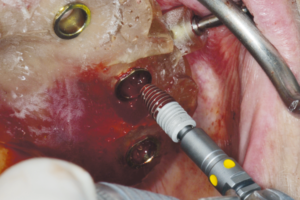AUTORES
Cássio Rodrigues Camargo
Engenheiro mecânico e mestrando em Engenharia Mecânica – Universidade Federal Fluminense (UFF).
Roberto Brunow Lehmann
Doutor em Engenharia Metalúrgica – Universidade Federal Fluminense (UFF).
RESUMO
Objetivo: verificar a influência da geometria do implante zigomático nas tensões em osso cortical e no próprio implante. Material e métodos: uma maxila previamente digitalizada foi simulada para o grau de reabsorção onde este tipo de terapia é necessário. Dois grupos foram criados: ambos receberam quatro impantes, sendo dois implantes anteriores de conexão hexagonal e corpo cônico (4 mm x 9 mm), e dois implantes posteriores zigomáticos (4,1 mm x 35 mm). Foram escolhidos os fabricantes 1 e 2, com diferenças de desenhos principalmente na região mais coronal (roscas). A barra protética sustentou um cantiléver de 10 mm, e 12 dentes foram montados na prótese. Uma carga vertical de 200 N (50 N em cada molar e 25 N em cada pré-molar) foi aplicada. Resultados: as tensões máximas (von Mises) no osso cortical e implante zigomático, respectivamente, no fabricante 1 foram 20,7 MPa e 164,5 MPa, e no fabricante 2 foram de 23,2 MPa e 83,70 MPa. Em ambos os implantes, foi observado o mesmo padrão de dissipação das tensões, ou seja, os maiores níveis foram verificados na região cervical e se dissiparam pelo corpo do implante até atingirem os menores níveis na região apical. Conclusão: o implante do fabricante 2 alcançou menores níveis de tensões, às custas de transferi-las ao osso cortical; em todas as simulações, os modelos tiveram um comportamento mecânico adequado.
Palavras-chave – Implantes zigomáticos; Elementos finitos; Brånemark; Análise de tensões.
ABSTRACT
Objective: to verify the geometric influence of the zygomatic implant on the stresses regarding the cortical bone and the implant itself. Material and methods: a previously digitized maxilla had a simulated bone resorption where this type of therapy is required. Two groups were created: both received four dental implants, being the two anterior fixations of hexagonal connection and conical body (4 mm x 9 mm) and the two posterior zygomatic implants (4.1 mm x 35 mm). Manufacturers 1 and 2 were chosen, with differences of designs mainly in the more coronal region (threads). The designed framework supported a 10 mm cantilever and 12 artificial teeth were mounted on the maxillary prosthesis. A vertical load of 200 N (50 N in each molar and 25 N in each premolar) was applied. Results: the maximum stresses (von Mises) on the cortical bone and zygomatic implant, respectively, for manufacturer 1 were 20.7 MPa and 164.5 MPa and for manufacturer 2 of 23.2 MPa and 83.70 MPa. In both implants, the same dissipation pattern was observed, that is, the highest levels were verified in the cervical region and dissipated through the implant body until reaching the lower levels in the apical region. Conclusion: the implant of the manufacturer 2 reached lower stress levels by transferring them to the cortical bone; for all simulations, the models presented adequate mechanical behavior.
Key words – Zygomatic implants; Finite elements; Brånemark; Stress analysis.
Recebido em set/2018
Aprovado em set/2018





